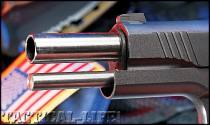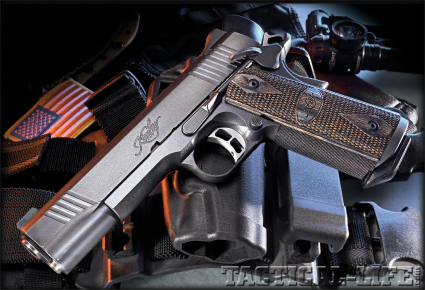When Kimber first introduced their line of 1911s, I thought they were making a terrible mistake. There were so many manufacturers and custom gun builders turning out endless variations of old slabsides that there would not be enough demand to warrant additional production. I was wrong.
 The 1911 continues to be an extremely popular pistol for many reasons. Over several decades of military service, the 1911 became known as an extremely reliable and effective sidearm. No other sidearm has seen so much service over such an extended period of time and still proven relevant to our contemporary environment. Even with the advent of polymer-framed pistols, this century old warhorse not only continues to serve, but thrive.
The 1911 continues to be an extremely popular pistol for many reasons. Over several decades of military service, the 1911 became known as an extremely reliable and effective sidearm. No other sidearm has seen so much service over such an extended period of time and still proven relevant to our contemporary environment. Even with the advent of polymer-framed pistols, this century old warhorse not only continues to serve, but thrive.
The 1911 is so popular that several well-known firearms behemoths produce multiple models. On top of that, there are smaller but equally well-known custom builders who specialize in the 1911. Finally, there are more 1911-specialist gunsmiths than any one individual could possibly track. With all of the options and availability to meet one’s 1911 needs, it’s difficult to know where to turn and what to buy.
Advertisement — Continue Reading Below
When choosing a 1911, I would encourage the prospective buyer to remember that there is no magic pixie dust that makes any one 1911 “the best.” Regardless of what the marketing people might want you to believe, 1911’s quality lies in the materials chosen and how those materials are crafted and fitted together. After that, it is a matter of deciding what aesthetic features we want and how much we are willing to pay for them.
Kimber entered late into the 1911 market but now enjoys a considerable market share of the business. In fact, Kimber is the world’s largest producer of 1911 pistols. This did not happen by accident. While I am sure they attribute much of their success to the management and production teams, I attribute their success to their product. I recently had the opportunity to evaluate the Kimber Tactical Custom HD II and can see why Kimber currently enjoys so much success.
Gun Details
One of Kimber’s 1911 features that I like and consider essential is their use of forged frames and slides. Forged steel handles the beating that the slide gives the frame much better than other materials. If I were not going to shoot a pistol a lot, I would use other materials without concern. But for any 1911 that expects to see a lot us use, stick with forged frames and slides. In the case of the Tactical Custom II, the frame is actually machined from stainless steel.
Advertisement — Continue Reading Below
The frame-to-slide fit of the Tactical Custom HD II is what I would call ideal for a working gun. Frame-to-slide fit, like any other specification, should be tailored to fit whatever role envisioned by the owner. Pistols made for competition should fit slides tightly, giving us the most accuracy. Pistols created for fighting, law enforcement or home defense should have a little wiggle room to accommodate the presence of dirt and debris while permitting the pistol to still function.
Additionally, the Tactical Custom HD II has some nice checkering in all the right places. When I was in the US Army, I attended a two-month CQB (close quarters battle) course that focused heavily on pistol marksmanship in combat. The phrase that I heard often and remember well was to “get as much meat on the gun as possible.”
When shooting a pistol rapidly, it is important to grasp the pistol firmly with both hands to control it under recoil. Pistols with smooth grips, front straps and back straps make it difficult to keep the pistol from twisting or moving while firing. Surfaces that we grip on a fighting pistol need to have an aggressive texture. The Tactical Custom HD II has 30-lpi (lines per inch) checkering on the front strap and 20-lpi on the flat mainspring housing. There is also 30-lpi checkering on the bottom of the triggerguard.
Advertisement — Continue Reading Below
The combination of checkering makes it possible to easily control the pistol while firing. I also thought that the checkering under the triggerguard was a nice touch because it allows us to get a little more meat on the gun. When grasping the pistol, it is natural to mash the middle finger of the firing hand and the index finger of the supporting hand into the triggerguard’s bottom. The checkering there gives an additional textured point of contact to help us control the gun under recoil. Every little bit helps.
The slide of the Tactical Custom HD II also comes with front slide serrations. The serrations enable us to easily conduct a press check to confirm the status of the weapon. It is a feature that I like and have on almost all of my 1911s.
Kimber also used a match-grade steel barrel in the pistol. With the use of a stainless steel bushing, Kimber found a way to prevent galling while still gaining the wear-resistant properties of stainless steel. A .45 ACP is not going to wear the barrel’s rifling out any time soon, but it can wear fairly quickly at barrel bushing.
Advertisement — Continue Reading Below
The pistol’s finishing is very good. Kimber knows how to make pistols pretty. The beavertail grip safety fits flush into frame with all of the corners blended nicely together. Kimber also polished the interior portion of the slide stop to reduce the friction created when cartridges feeding towards the chamber move past it. This decreases the possibility of a cartridge pushing the slide stop into position and locking the slide to the rear when there are still rounds in the magazine.
The only area of the pistol that could use a purely cosmetic touch up is the magazine well. Kimber included an extended and beveled magazine well, but did not blend the bottom of the frame to it—there is a small seam between the two. This imperfection does not adversely affect the pistol’s operation in the slightest. I recognize that blending the magazine well would be an entirely cosmetic improvement because try as I might, I could not get a magazine to catch on it.
Shooting Impressions
Of course the proof of any firearm is in the shooting. The Tactical Custom HD II proved to be an excellent example of the classic 1911 design. It functioned with 100 percent reliability and excellent accuracy. The Tactical Custom HD II demonstrated excellent controllability with marginal muzzle rise and minimal felt recoil considering the .45 ACP round. The pistol’s excellent trigger contributed in no small measure to the overall accuracy and controllability of the pistol.
Advertisement — Continue Reading Below
The forged frame and slide, checkering, sight cuts, and lowered and flared ejection port all mean that I can purchase a quality 1911 at a fraction of the cost of a full-house custom 1911. There are only a few changes that I will make to this pistol in the future.
I will change out the hammer, sear and disconnector. The pistol’s trigger is exceptional for an out-of-the-box 1911, but I do not own a 1911 that has not had the trigger and sear polished and a little tuning done. Kimber uses MIM (metal injection molded) parts for hammers, sears and disconnectors and they function properly. On this pistol they even function very well. However, MIM parts do not hold polishing jobs. If you intend on getting a trigger job done, you should change these parts out in the process. Some think MIM parts are Satan’s spawn—do not believe them. It is just a case of a functionally sound manufacturing process being “what if’d” to death.
With these two small changes, I will have a 1911 that will rival any of the most expensive 1911s on the market and at a fraction of the cost. I have a hard time justifying spending thousands of dollars on a pistol, especially when most of that price tag is for aesthetics and the name on the slide. While I do believe that there is a place for really expensive 1911s and appreciate the beauty found therein, I am just not quite rich enough to own one myself.
Advertisement — Continue Reading Below
For more information contact: Kimber, 1 Lawton St, Dept CH, Yonkers, NY 10705; 800-880-2418; www.kimberamerica.com
























